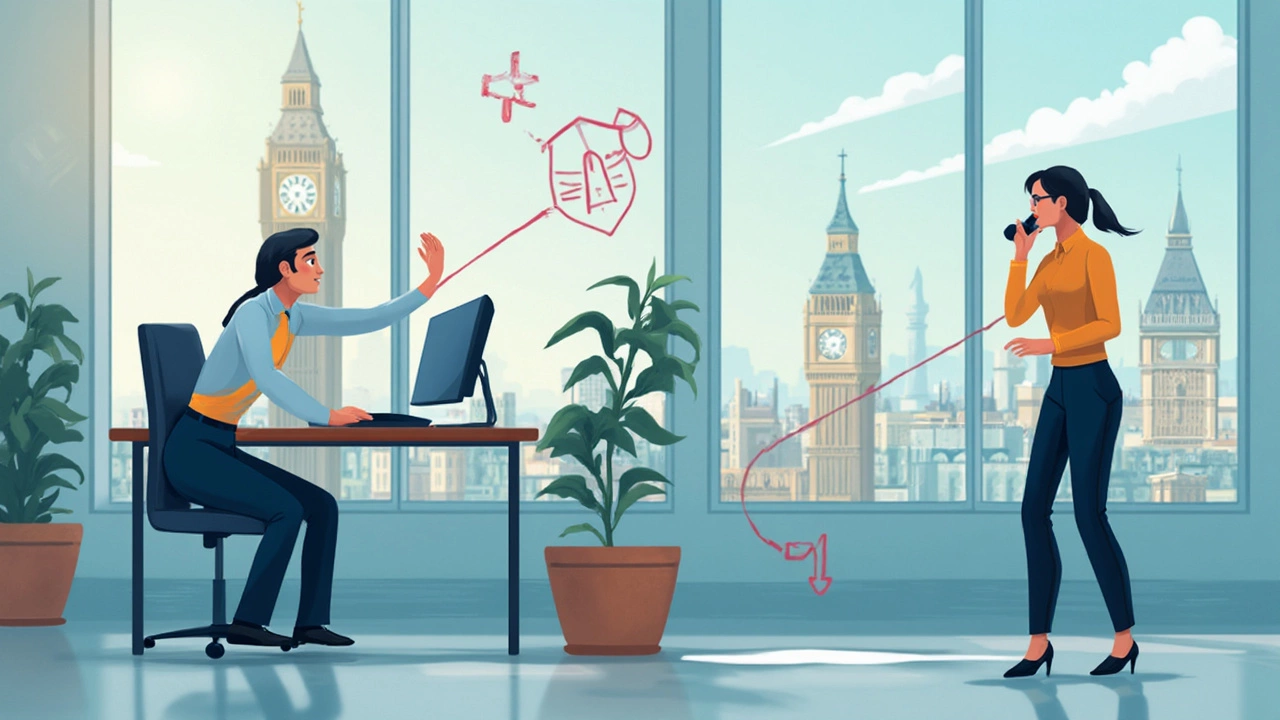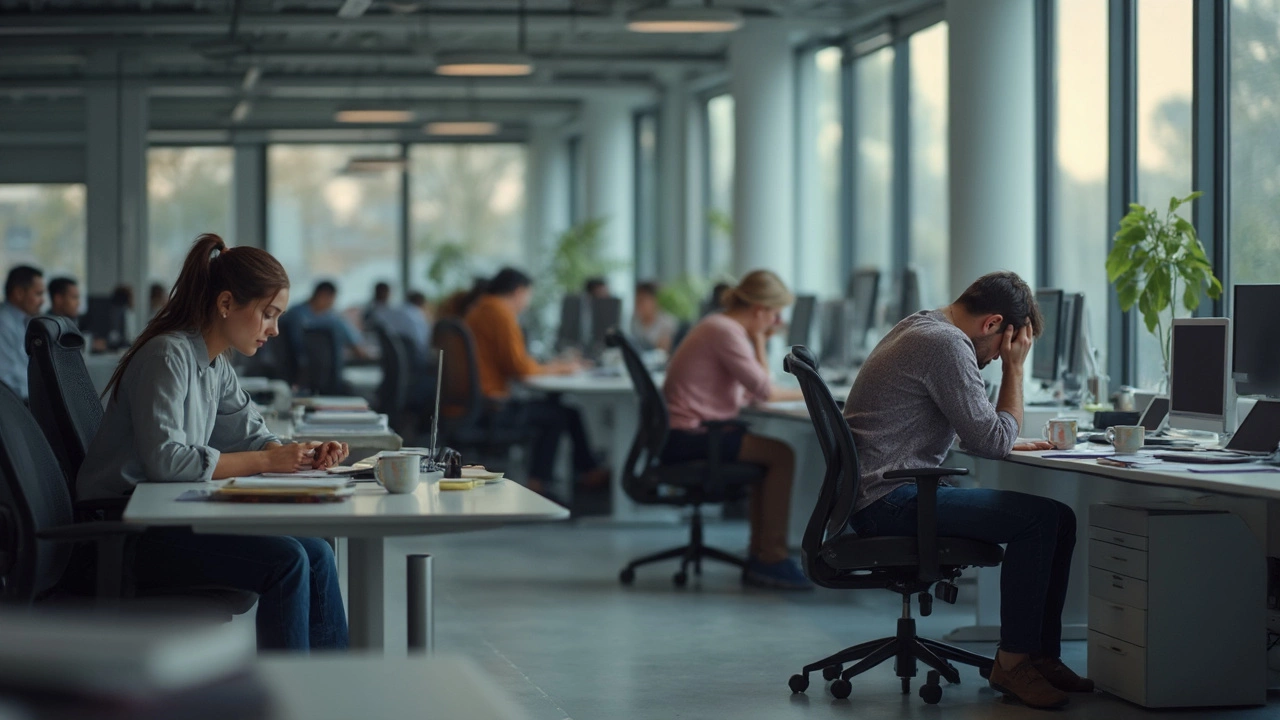If you clock in at a desk all day, you already know how stiff your back can feel by noon. A lot of people think a nice office chair is enough to keep them healthy, but the truth is, our bodies just aren’t built to sit for hours on end. You might not notice it right away, but too much sitting can sneak up on you with back pain, tight hips, and even headaches. Think of your office chair as a tool—a good one can help, but it doesn’t erase the risks.
Ever wondered why you feel more tired sitting down all day than if you’d gone for a long walk? That’s because sitting for long stretches slows your metabolism, which messes with how your body deals with blood sugar and fat. Even if you work out a few days a week, hours of sitting can still undo a lot of that good work. That’s why health pros call sitting the new smoking. It sounds dramatic, but science backs it up.
- What Happens to Your Body When You Sit All Day
- Does a Good Office Chair Make a Difference?
- Real Risks: Back Pain, Stiff Joints, and More
- Easy Ways to Add Movement to Your Office Routine
- When Should You Worry or Make a Change?
What Happens to Your Body When You Sit All Day
Sitting all day might sound harmless, but it takes a toll on your body way faster than you might think. When you stay planted in your office chair for hours, your muscles shut down, especially the big ones in your legs and back. Blood flow slows down, which makes it easier for fat to build up in your blood vessels. No wonder doctors say it can put your heart at risk.
One of the biggest things that happens is your calorie burn drops off fast. Even just standing uses more energy. That’s why people who sit most of the day have a higher chance of weight gain. Also, your muscles get weaker. They basically “forget” how to support you, which leads to bad posture and aches—even for folks who try to sit up straight.
Check out these quick facts on how too much sitting impacts your health:
| Body Part | What Happens When You Sit Too Long |
|---|---|
| Back and Neck | Poor posture and pain |
| Legs | Weaker muscles and stiff joints |
| Heart | Higher risk for heart disease |
| Brain | Less oxygen and slower memory |
| Blood Sugar | Harder to process sugar—more diabetes risk |
What’s wild is that “tech neck” from looking down at screens is now so common, chiropractors see it every day. If you were to count the hours most of us spend in a office chair, it’d surprise you. The CDC found that adults in the US spend over six hours a day sitting, some even more if you add in TV time after work.
There’s also a mental side. When you’re glued to your chair, your mood can shift. You might notice more stress, lower energy, and sometimes even trouble concentrating. So, the longer you sit, the more your body gets used to being stuck in one position, and the harder it is to snap out of it. Getting up regularly isn’t just a good idea—it’s pretty much the only way to keep your system running well day after day.
Does a Good Office Chair Make a Difference?
Here’s where a lot of people get confused. Sitting on any old chair for hours is a recipe for soreness, but swapping it out for an ergonomic office chair really can help—if you use it right. A good chair supports your lower back, keeps your hips level, and lets your feet rest flat on the ground. That means way less slouching, fewer hunched shoulders, and less pressure on your spine. The office chair you pick matters, but setting it up the right way matters just as much.
The top chairs out there aren’t just about looks or fancy features. They let you adjust the height so your knees stay at a ninety-degree angle. They’ve got a backrest that matches the curve of your back and armrests that support your elbows without making you shrug your shoulders. Some studies show that folks who switch to a well-designed chair report less back and neck pain within a few weeks.
But—and this is big—even the best chair in the world can’t cancel out all the risks that come from being parked in one spot for hours at a stretch. You still need to get up, stretch, and move around every so often. Here are some quick setup tips that make a real difference:
- Keep the chair height so your feet sit flat and your knees are level with your hips.
- Make sure the backrest supports the natural curve of your spine (some people use a small pillow if the chair doesn’t help enough).
- Adjust the armrests so your elbows bend at about 90 degrees and your shoulders are relaxed.
- Position your screen at eye level, so you’re not bending your neck all day.
If your chair doesn’t do all this, you don’t need to shell out for something expensive right away. Even a rolled-up towel or a stack of books can help adjust your seat in the meantime. The main point: the right office chair helps, but it’s not a cure-all. You’ve still got to give your body a break every hour or so if you want to feel your best by the end of the workday.

Real Risks: Back Pain, Stiff Joints, and More
Sitting all day in your office chair can do more than just make you feel a bit lazy or tired. There are real health risks that go way beyond comfort. Here’s what actually happens in your body when you stick to your chair for hours without moving enough:
- Back pain: This is the big one. Slouching or leaning forward to check your screens puts extra pressure on your lower spine. It isn’t just uncomfortable—it can lead to long-term issues like herniated discs or chronic pain.
- Stiff joints: Ever stand up and feel like you’ve aged ten years? Joints, especially in your hips and knees, tighten up when you stay in one position too long. It gets worse the longer you sit, and can actually reduce your flexibility over time.
- Poor blood flow: Staying still slows down your circulation, especially in your legs. This means blood tends to pool in your lower body, which sometimes causes swelling or a tingling feeling.
- Neck and shoulder pain: Hunching over a keyboard or screen cramps up your shoulders and neck. If your monitor isn’t at eye level, you’ll feel it even more.
- Higher chances of health problems: Sitting for long periods over years links to bigger health risks, like heart disease and diabetes. It’s not just office gossip—this is in real medical research.
Here’s a quick snapshot of how common the major problems are among desk workers:
| Risk | % of Desk Workers Affected |
|---|---|
| Back pain | 65% |
| Neck/Shoulder pain | 48% |
| Stiff hips/knees | 34% |
| Poor circulation | 27% |
There’s more—if you stay glued to your chair too much, your muscles, especially in your core and legs, can get weaker because you’re not using them. Less muscle means less support for your body, which only makes things worse. If you find yourself constantly needing to shift in your seat or if you get sore by the end of the workday, your body’s telling you it’s time to move more. Listen to it.
Easy Ways to Add Movement to Your Office Routine
Even if you’re stuck at a desk job, squeezing in some movement isn’t as tough as it sounds. Tiny tweaks to your workday can help your body way more than you think. For example, studies from the CDC say standing up and moving every 30 minutes can cut down the health risks connected with sitting all day. That’s easier than it sounds—it doesn’t mean you have to sprint laps around the office.
- Office chair breaks: Set a timer or use an app that nudges you to stand up, stretch, or walk around for a couple minutes every half hour.
- Walking meetings: Grab your next phone call and pace around instead of staying glued to your seat. Even a short stroll while chatting makes a difference.
- Hydration hacks: Keep your water bottle far from your desk. Needing to refill or grab water gives you an easy excuse to move.
- Stair time: Skip the elevator and take the stairs whenever you can, even if it’s just one or two floors.
- Desk exercises: Do simple stretches, calf raises, or shoulder rolls while you read emails or wait for files to load. No one’s judging.
All these moves might look tiny, but together, they wake up your muscles and joints, get your blood flowing, and keep your energy up. Try mixing two or three into your schedule and see how you feel after a week. Even my cat, Whiskers, perks up when I move around the house during work breaks—maybe you’ll inspire your co-workers or pets too.

When Should You Worry or Make a Change?
Most people brush off sore backs or stiff necks as normal, but paying attention to these signals can spare you from bigger problems down the road. If you get up from your office chair and constantly feel achy or numb—especially in your lower back, hips, or legs—it’s time to rethink your routine. Numbness, tingling, or sharp pains aren’t just annoying; they’re red flags that too much sitting could be messing with your nerves or blood flow.
Another warning sign: headaches or eye strain that seem to show up after long stretches at your desk. That’s often from awkward posture or staring at screens without enough breaks. If you start noticing swelling in your ankles, trouble standing up straight, or pain that just doesn’t quit, your body is basically yelling at you to switch things up.
- If pain sticks around for a week or more, don’t try to just tough it out. See a doctor or a physical therapist. Chronic pain can lead to serious issues if you ignore it.
- If you notice your mood dipping, or you’re constantly tired even after sleep, your inactivity could be a factor. A study from 2023 connected long-term sitting with higher risks of depression and fatigue.
- Keep an eye out for changes in your posture—like rounded shoulders or a head that juts forward. These can sneak up on you and lead to ongoing problems if you don’t address them early.
The trick is to act while things are still minor. Try simple changes first: stand up every 30 or 40 minutes, stretch during calls, or add a short walk to your lunch break. If nothing helps, or the pain gets worse, consider switching up your workspace or investing in a sit-stand desk. And if you feel unsure, always check with a pro. Taking these steps can make all the difference in how you feel day after day.





